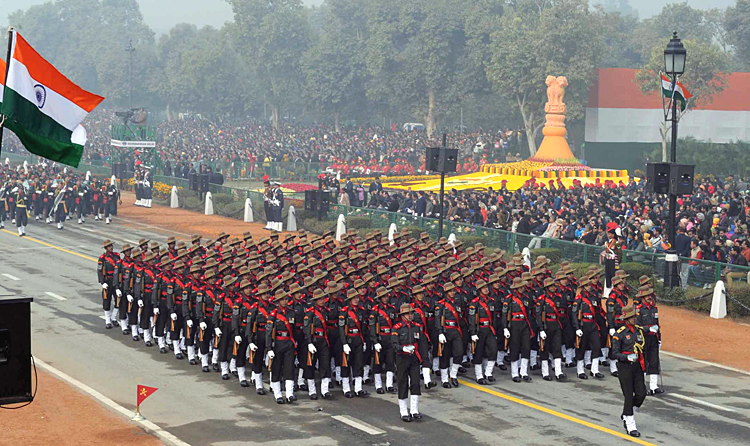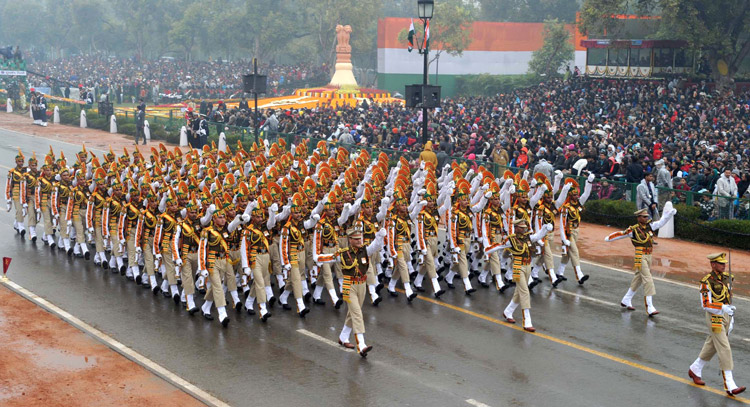INDIAN ARMED FORCES CHIEFS ON OUR RELENTLESS AND FOCUSED PUBLISHING EFFORTS

The insightful articles, inspiring narrations and analytical perspectives presented by the Editorial Team, establish an alluring connect with the reader. My compliments and best wishes to SP Guide Publications.

"Over the past 60 years, the growth of SP Guide Publications has mirrored the rising stature of Indian Navy. Its well-researched and informative magazines on Defence and Aerospace sector have served to shape an educated opinion of our military personnel, policy makers and the public alike. I wish SP's Publication team continued success, fair winds and following seas in all future endeavour!"

Since, its inception in 1964, SP Guide Publications has consistently demonstrated commitment to high-quality journalism in the aerospace and defence sectors, earning a well-deserved reputation as Asia's largest media house in this domain. I wish SP Guide Publications continued success in its pursuit of excellence.
- Prime Minister Modi Visits Punjab’s Adampur Air Base, Interacts with Airmen after Successful ‘Operation Sindoor’; Stern Message to Pakistan
- The layered Air Defence systems that worked superbly, the key element of Operation Sindoor
- Operation Sindoor | Day 2 DGMOs Briefing
- Operation Sindoor: India strikes back with Precision and Purpose
- Operation Sindoor: Resolute yet Restrained
- India’s Operation Sindoor Sends a Clear Message to Terror and the World – ‘ZERO TOLERANCE’
- Japan and India set forth a defence cooperation consultancy framework, talks on tank and jet engines
- Terrorist Attack in Pahalgam in Kashmir: Unfolding a long surgical war against PAK
- Lt General Pratik Sharma takes over Command of Indian Army's Northern Command
AR-ITBP Merger – will the 'deep state' succeed?
 |
The Author is Former Director General of Information Systems and A Special Forces Veteran, Indian Army |

It is important to understand the 'real' reason behind the call for merger of Assam Rifles (AR) and ITBP, which media doesn't mention. The 'deep state' has struck again through the MHA; merger to bring AR completely under MHA, whose operational control is presently under Army. Core of the 'deep state' is the IPS-bureaucrat nexus with select politicians roped in. By virtue of manning intelligence agencies, the IPS is privy to skeletons of politicians and bureaucrats. That is why all senior appointments in central armed police forces (CAPF) continue to be manned by IPS. That is why police forces are being given better pay, allowances and privileges than Armed Forces.
The deep state has no compunctions in money-making even at the cost of national security. Take for example the current furor over illegal immigrants in West Bengal in 70 years of communist rule, but aren't CAPF manning Bangladesh border under MHA? Illegal immigrants have been paying money for entering India, as well as Indian identity document arranged in proximity of the border at designated spots. The border with Myanmar is a gold mine – narcotics (same quantity as entering India from the West), costly goods, weapons, you name it. That is the why the deep state wanted control of this border since long, UPA II wanted BSF to man the Indo-Myanmar border, the question appeared settled in 2014, but now MHA has mooted the case once again.
The Kargil Review Committee and Group of Ministers recommended deployment of CAPF along international borders to augment Army but stipulated they must be placed under command Army; the deep state won't allow that. The proposed merger will also further emasculate the Army, which the deep state has been assiduously endeavoring. In contrast, the merger will open the flood gates for more IPS officers in Assam Rifles not only in senior appointments but also replacing all Army officers on deputation with the AR. The Cabinet Committee on Security (CCS) headed by the Prime Minister, is to examine the AR-ITBP merger. The manner in which the case is presented will matter. The Army has already forcefully projected the operational disadvantages to MoD. The MHA has already prepared the draft case for CCS. Service Chiefs are not part of CCS and with close rapport between the PM and the HM, the merger hopefully is not a foregone conclusion. Even if the Army Chief is summoned for the particular CCS meet, he may just decide to tow the line. The media saying that AR has long suffered due to dual control, without explaining what that suffering is does sound mischievous.

The nearly 65,000-strong AR comprising 46 battalions, has been guarding India's border with Myanmar as also provides operational and logistics support to Army in keeping vigil in key sectors in Arunachal. In addition, AR has been conducting counter-insurgency operations in the northeast. Through its performance, the AR has truly lived up to its motto of 'Sentinels of the North East'. Till 2009, it manned the LAC from Sikkim to Arunachal jointly with Army, and also supervised Bhutan and Myanmar borders. It excelled in both World Wars, in Sri Lanka as part of IPKF and when deployed under the UN flag. Two AR battalions (7 AR and 26 AR) deployed in Kashmir Valley in early 1990s both won the COAS Unit Citation. The force recently undertook joint operations with the Myanmar Army. The biggest concerns for the Army are that losing control of AR would impact Army's capability to guard the sensitive border with China, as also seriously jeopardize surveillance over the LAC when China has been ramping up military infrastructure right up to the LAC. Media has quoted a senior Army officer in saying, "The Assam Rifles fills the void when Army units carry forward the battle to the enemy territory. This is the only genuine paramilitary force which actively participated in all wars since Independence, including the 1962 and 1971 wars. Shifting the operational control of the Assam Rifles from the Army to the Home Ministry will severely jeopardize the surveillance along the Line of Actual Control with China." If Army loses operational control of AR, Army officers will not be posted on deputation to AR anymore. This will also disrupt existing Army-AR synergy in CI grid of the northeast, as is achieved in J&K between the Army and Rashtriya Rifles (RR). The AR will also lose its fighting edge given the media narrative that IPS officers in ITBP rarely go to inhospitable borders except short inspections and similarly IPS officers on deputation to BSF or CRPF deployed in Maoist-infested states or in Kashmir Valley rarely get involved in actual operations on the ground since they occupy higher offices of DIG and above. In contrast, Army officers on deputation to AR from the lowest rank upwards lead the men from the front; same as in regular Army units. Clearly, placing the AR totally under the MHA will have adverse implications for national security. Its transformation into another CAPF may force additional Army deployment in the northeast considering increasing China-Pakistan potential to foment trouble in the region. The Modi Government has made many big changes reversing the status quo trend. It is time to heed the KRC and GoM recommendations to place all forces deployed on international borders under command the Army – this should include the BSF, ITBP, SSB, CRPF as applicable. Also, keeping aside the CRPF which is considered the primary force for CI, the BSF, ITBP and SSB could be merged into a single force, unless there are fears of the new force becoming too strong, and a CAPF coup? The system of IPS (who deal basically with law and order) occupying higher posts in BSF, CRPF, ITBP and deliberately not promoting officers of these forces to higher posts must be reversed. Finally, it is up to Defence Minister Rajnath Singh to defend the issue at the CCS and not let the AR go out of Army's operational control.





